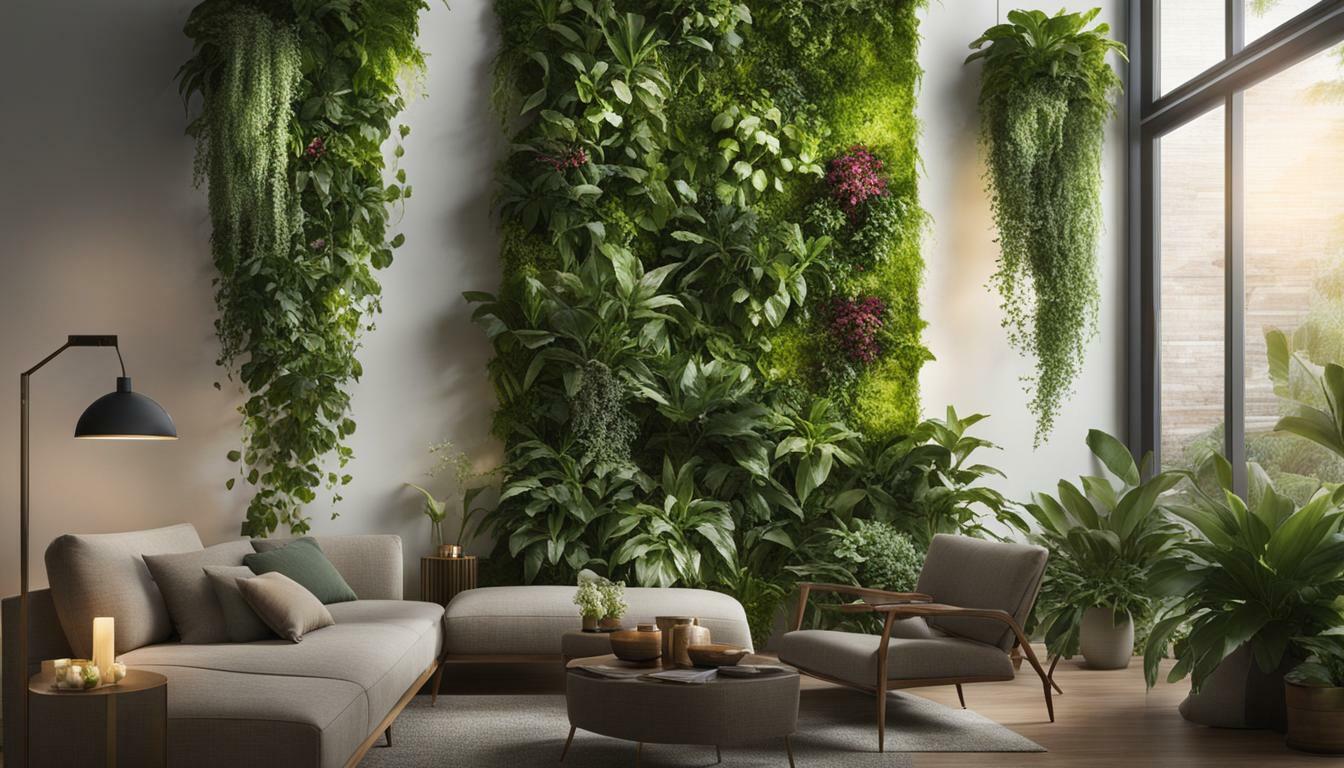Are you looking for ways to transform your home into a lush, edible paradise? Indoor vertical gardens are the perfect way to add some greenery indoors without taking up extra space. They come in many shapes and sizes, from wall-mounted planters to traditional pots.
Vertical gardening is a type of gardening that maximizes space by growing plants in a vertical stack. These gardens make the most efficient use of limited space through creative vertical gardening and improving food security. Upward-directed plant growth is a highly effective growth technique that maximizes the potential of each square foot to produce more food in less area. Indoor vertical gardens allow you to grow food, herbs, and flowers in the comfort of your home.
Indoor vertical gardens are especially popular because they’re easy to install, low maintenance, and don’t take up too much space. You can grow plants on a green wall installed or get an indoor vertical garden system composed of shelves connected with support structures. Or you can even go for a simple solution like hanging planters from the ceiling.
If you’re looking for the best indoor vertical garden technologies, look no further! Many different types of indoor gardens are available on the market today, from green walls to traditional pots.
But before you go and purchase one, you need to consider how much space you have, how many plants you’d like to grow, and how much you are willing to pay.
We’ve rounded up some of our favorites for you here so you can choose the perfect one for your home. Read on to learn more about these five systems and what makes them great choices for your indoor garden!
Key Takeaways:
- Indoor vertical gardens are a great way to add greenery to your home without taking up extra space.
- Vertical gardening maximizes space by growing plants in a vertical stack, making efficient use of limited space.
- There are different types of indoor vertical garden systems available, including green walls, shelves, and hanging planters.
- Consider factors such as space availability, desired plant quantity, and budget when choosing an indoor vertical garden.
- Some popular indoor vertical garden systems include Gardyn, Lettuce Grow, and The Wall Farm.
Benefits of Vertical Gardening
Vertical gardening offers numerous benefits for both small and large spaces, making it an ideal choice for any home or office. Here are some of the key benefits:
- Maximizes space: Vertical gardening allows you to make the most of limited space by growing plants in a vertical stack. By utilizing vertical space, you can grow more plants in a smaller area, perfect for those with limited outdoor space or urban dwellers.
- Improves food security: With upward-directed plant growth, vertical gardening maximizes the potential of each square foot, allowing you to produce more food in less area. This can be especially beneficial for those looking to grow their own food or for communities with limited access to fresh produce.
- Easy installation and low maintenance: Indoor vertical gardens are easy to install and require minimal maintenance. You can choose from a variety of systems, such as wall-mounted planters, shelves connected with support structures, or hanging planters. These systems are designed to be user-friendly and require less time and effort to maintain compared to traditional gardens.
- Brings nature indoors: Indoor vertical gardens allow you to bring the beauty of nature into your home. They provide a refreshing and calming environment, helping to reduce stress and improve overall well-being. Studies have also shown that having plants indoors can improve air quality by reducing pollutants and increasing humidity.
With the growing popularity of vertical gardening, there are now various systems and technologies available on the market. Let’s take a closer look at some of the options and what makes them great choices for your indoor garden.
Table: Comparison of Indoor Vertical Garden Systems
| Type of System | Measurements | Growing Capacities | Watering | Watering Tank | Growing Lights | Electricity Usage per Month | Connected App | Warranty | Terms |
|---|---|---|---|---|---|---|---|---|---|
| Hydroponics | 24”W x 12”D x 64”H | 30 plants | Automatic | 19L | 2 full-spectrum LED grow lights with attached cameras | 54kWh | In-app device control | 1 Year | Free Shipping & 60-day returns |
| Hydroponics | 3’8″ H x 1’10” dia. – 6’1″ H x 1’10” dia. | 12-36 plants | Automatic | 77L tank | Energy-efficient LED lights | $4.5 | – | 3 Years | Free Shipping & 90-day returns |
| Hydroponics | 79.6”W x 53.1”D x 15.7”H | 51 plants | Automatic | 35L tank | Professional-grade LED lights | 57.6kWh | – | 1 Year | 30-day returns |
These are just a few examples of the indoor vertical garden systems available on the market. Each system comes with its own unique features, such as automatic watering, LED grow lights, and connected apps for easy control and monitoring. When choosing a system, consider factors such as the number of plants you want to grow, the size of the system, and the warranty and terms offered by the manufacturer.
Now that you have a better understanding of the benefits and options for indoor vertical gardening, you can choose the perfect system for your home or office. Whether you prefer the all-in-one hydroponic system like Gardyn or the innovative Wall Farm Indoor Vertical Garden, there are plenty of options to suit your needs. Start transforming your space with a vertical wall garden and enjoy the beauty and benefits of indoor gardening.
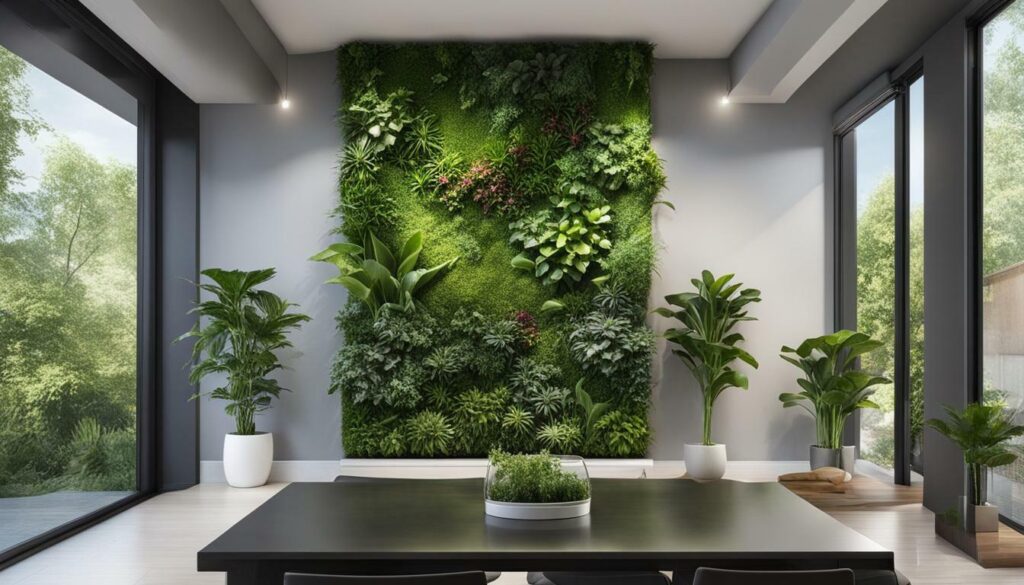
Sources:
Understanding Vertical Gardening Systems
Vertical gardening is a type of gardening that maximizes space by growing plants in a vertical stack, allowing for efficient use of limited space and improved food security. These gardens are designed to make the most of every square foot, utilizing creative vertical gardening techniques to produce more food in less area. Indoor vertical gardens specifically offer the opportunity to grow food, herbs, and flowers within the comfort of your home.
There are various types of indoor vertical gardening systems available on the market, each with its own unique features and benefits. These systems range from wall-mounted planters to shelves connected with support structures, or even simple hanging planters from the ceiling. The choice of system depends on factors such as available space, desired number of plants, and budget.
Hydroponic Vertical Garden Systems
One popular type of indoor vertical gardening system is hydroponics, which involves growing plants without soil, using a nutrient-rich water solution. Hydroponic systems are known for their efficiency and ability to produce high yields in a compact space. They typically feature automatic watering systems and LED grow lights to provide the plants with optimal growing conditions.
A notable hydroponic system is the Gardyn, an all-in-one home kit that offers organic seeds and AI technology to support healthy plant growth. This system includes 30 yCubes with various non-GMO plant seeds, LED grow lights with attached cameras, and an in-app device control for easy management. With its compact size and water-efficient design, the Gardyn is suitable for small spaces and offers a sustainable indoor gardening solution.
Another hydroponic option is the Lettuce Grow Farmstand tower, which can hold up to 36 plants. This system features an automated water distribution system, energy-efficient LED lights, and a range of seasonal varieties to choose from. With its ease of use and eco-friendly attributes, the Lettuce Grow Farmstand is a convenient choice for growing fresh produce indoors.
| Type of System | Measurements | Growing Capacities | Warranty | Electricity Usage per Month | Watering | Watering Tank | Growing Lights | Terms |
|---|---|---|---|---|---|---|---|---|
| Hydroponics | 24”W x 12”D x 64”H | 30 plants | 1 Year | 54kWh | Automatic | 19L | 2 full-spectrum LED grow lights with attached cameras | Free Shipping & 60-day returns |
| Hydroponics | 3’8″ H x 1’10” dia. – 6’1″ H x 1’10” dia. | 12-36 plants | 3 Years | $4.5 | Automatic | 77L | Energy-efficient LED lights | Free Shipping & 90-day returns |
Another notable indoor vertical gardening system is The Wall Farm Indoor Vertical Garden. This system features three shelves and 51 growing cavities, making it suitable for gardeners of all levels. It includes a semi-automatic watering system and professional-grade LED lights for optimal plant growth. With its innovative design and user-friendly features, The Wall Farm Indoor Vertical Garden offers an easy way to maintain an indoor garden.
In conclusion, indoor vertical gardening systems provide a practical and efficient way to grow plants in limited spaces. Whether through hydroponics or other types of systems, these innovative solutions offer the opportunity to cultivate fresh produce, herbs, and flowers within the comfort of your home. By considering factors such as space availability, number of plants desired, and budget, you can choose the right vertical garden system to transform your space into a thriving green oasis.
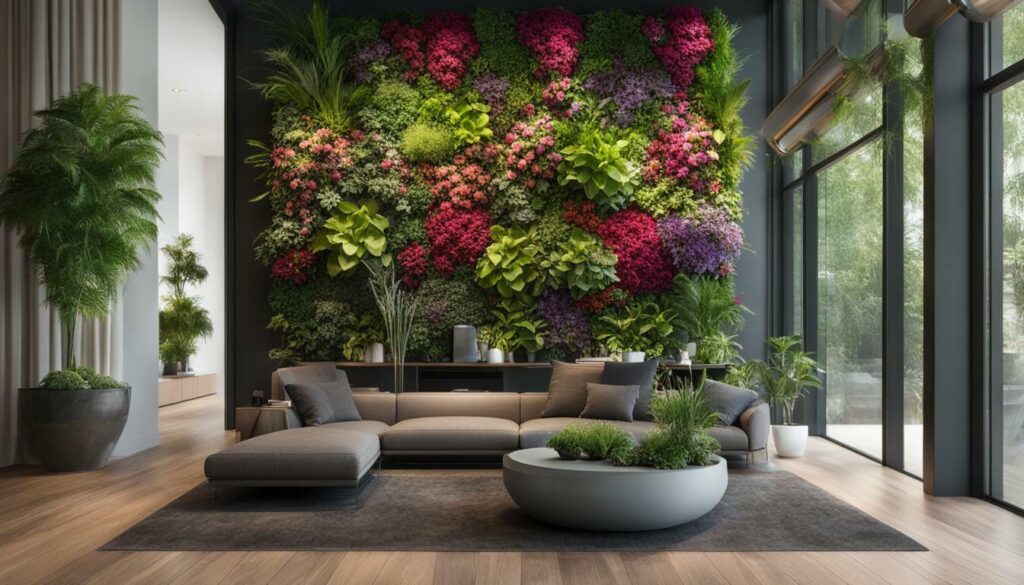
Choosing the Right Vertical Garden System
When it comes to selecting a vertical garden system, there are several factors to consider, including space availability, desired plant capacity, and budget. With so many options available on the market, it can be overwhelming to find the perfect system for your needs. To help you make an informed decision, here are three top vertical garden systems to consider:
Gardyn
Gardyn is an all-in-one home kit that provides a hassle-free solution for indoor vertical gardening. With its compact design, it can fit right on your kitchen countertop, making it perfect for small spaces. The system features 30 yCubes with non-GMO plant seeds for easy germination, including vegetables, herbs, and fruits. What sets Gardyn apart is its use of AI technology, organic seeds, and powerful LED grow lights with attached cameras, allowing you to monitor and care for your plants remotely. With 95% less water usage than other indoor mini-greenhouses, Gardyn is not only efficient but also environmentally friendly. Plus, it comes with a 1-year warranty and free shipping with 60-day returns.
Lettuce Grow
Lettuce Grow is another excellent option for indoor vertical gardening. Their hydroponic system, called the Farmstand, can hold up to 36 plants at a time, allowing you to grow a variety of vegetables, fruits, herbs, and edible flowers. The system is easy to set up and maintain, requiring weekly water and nutrient replenishment. Lettuce Grow also offers over 50 seasonal varieties of produce to choose from. With 95% lower water usage and a commitment to donate one Farmstand for every 10 sold, Lettuce Grow is both sustainable and socially responsible. The system is backed by a 3-year warranty and comes with free shipping and 90-day returns.
The Wall Farm Indoor Vertical Garden
If you’re looking for a versatile vertical gardening system, The Wall Farm Indoor Vertical Garden is worth considering. With its three shelves and 51 growing cavities, it’s suitable for gardeners of all levels. The semi-automatic watering system with a 35-liter tank ensures your plants receive the right amount of water. The system features professional-grade LED lights for optimal plant growth. The Wall Farm offers a 1-year warranty and requires an electricity usage of 57.6kWh per month. With its efficient use of space and user-friendly design, The Wall Farm is a reliable choice for indoor vertical gardening.
When deciding on a vertical garden system, take into account your available space, desired plant capacity, and budget. Consider the features and warranties offered by each system to ensure you choose one that best fits your needs. With the right vertical garden system, you can transform your space into a thriving indoor oasis.
| Type of System | Measurements | Growing Capacities | Warranty | Electricity Usage per Month | Watering | Watering Tank |
|---|---|---|---|---|---|---|
| Gardyn | 24”W x 12”D x 64”H | 30 plants | 1 Year | 54kWh | Automatic | 19L |
| Lettuce Grow | 3’8″ H x 1’10″ dia. – 6’1″ H x 1’10″ dia. | 12-36 plants | 3 Years | $4.5 | Automatic | 77L |
| The Wall Farm Indoor Vertical Garden | 79.6×53.1×15.7 in | 51 plants | 1 Year | 57.6kWh | Automatic | 35L |
Hydroponic Vertical Garden Systems
Hydroponic vertical garden systems are a popular choice for indoor gardening due to their ease of installation, low maintenance, and space-saving design. These systems utilize a soil-less growing method, where plants are grown in nutrient-rich water solutions, providing optimal conditions for growth and reducing the risk of pests and diseases. They are especially beneficial for those with limited space or living in urban areas where traditional gardening may not be feasible.
When considering a hydroponic vertical garden system, it’s important to choose one that suits your specific needs and preferences. Factors to consider include the size of the system, the number of plants it can accommodate, the watering mechanism, the type of lighting provided, and the warranty and terms offered by the manufacturer.
To give you a better idea of some popular hydroponic vertical garden systems, here are a few examples:
| Type of System | Measurements | Growing Capacities | Warranty | Electricity Usage per Month | Watering | Watering Tank | Growing Lights | Terms |
|---|---|---|---|---|---|---|---|---|
| Gardyn | 24”W x 12”D x 64”H | 30 plants | 1 Year | 54kWh | Automatic | 19L | 2 full-spectrum LED grow lights with attached cameras | Free Shipping & 60-day returns |
| Lettuce Grow | 3’8″ H x 1’10” dia. – 6’1″ H x 1’10” dia. | 12-36 plants | 3 Years | $4.5 | Automatic | 77L tank | Energy-efficient LED lights | Free Shipping & 90-day returns |
| The Wall Farm Indoor Vertical Garden | 79.6×53.1×15.7 in | 51 plants | 1 Year | 57.6kWh | Automatic | 35L tank | Professional-grade LED lights | 30-day returns |
These are just a few examples of hydroponic vertical garden systems available in the market. Each system offers its own unique features and benefits, so it’s important to consider your specific requirements when making a purchase.
By choosing the right hydroponic vertical garden system, you can enjoy the benefits of indoor gardening and transform your space into a lush, green oasis. Whether you’re a beginner or an experienced gardener, these systems provide a convenient and efficient way to grow your own fresh produce, herbs, and flowers all year round.
Now that you are familiar with hydroponic vertical garden systems, you can explore further and choose the system that best suits your needs and preferences. With a hydroponic vertical garden, you can enjoy the benefits of gardening in a limited space, enhance your interior design with nature’s touch, and cultivate a thriving indoor garden.
Lettuce Grow – An All-in-One Hydroponic System
Lettuce Grow is an all-in-one hydroponic system that allows you to easily grow a variety of vegetables, fruits, and herbs indoors with minimal effort. This innovative system is perfect for those who want to enjoy the benefits of homegrown produce but have limited space or lack outdoor gardening options.
With Lettuce Grow, you can grow up to 30 plants at a time, making it ideal for small spaces like apartments or kitchens. The system utilizes hydroponic technology, which means plants are grown in water without soil, resulting in faster growth and higher yields. Hydroponics also eliminates the need for traditional gardening maintenance tasks like weeding and soil preparation.
One of the standout features of the Lettuce Grow system is its use of AI technology. The system is equipped with powerful LED grow lights that provide the ideal spectrum of light for plant growth. These lights are paired with attached cameras and sensors that monitor the health and progress of your plants. The AI technology detects any issues or deficiencies and provides real-time feedback, ensuring optimal growing conditions and maximizing the success of your indoor garden.
| Type of System | Measurements | Growing Capacities | Warranty | Electricity Usage per Month | Watering | Watering Tank | Growing Lights | Terms |
|---|---|---|---|---|---|---|---|---|
| Hydroponics | 24”W x 12”D x 64”H | 30 plants | 1 Year | 54 kWh | Automatic | 19L | 2 full-spectrum LED grow lights with attached cameras | Free Shipping & 60-day returns |
The Lettuce Grow system is designed to be user-friendly and requires minimal maintenance. The automatic watering feature ensures your plants receive the correct amount of water at the right time, eliminating the guesswork and the risk of over or under-watering. The system also includes a 19L water tank, reducing the need for frequent refills.
In addition to its practical features, Lettuce Grow is committed to sustainability. The system uses 95% less water than traditional gardening methods, making it an eco-friendly choice. Lettuce Grow also donates one system for every 10 sold to teachers, educators, schools, nonprofits, or community organizations, making a positive impact on the community.
“Lettuce Grow is an all-in-one hydroponic system that offers a convenient and efficient way to grow fresh produce indoors. With its AI technology, easy maintenance, and commitment to sustainability, it is an excellent choice for anyone looking to transform their space into a thriving indoor garden.”
If you’re ready to transform your space and enjoy the benefits of homegrown produce, Lettuce Grow is the perfect solution. With its compact size, innovative features, and user-friendly design, it’s never been easier to have a thriving indoor garden. Start growing your own fresh food today with Lettuce Grow!
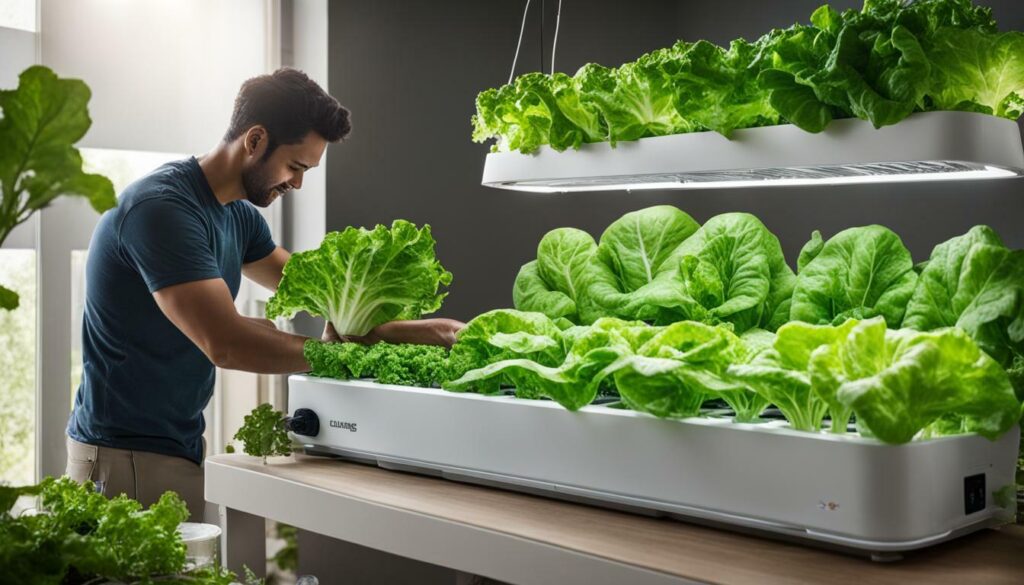
The Wall Farm Indoor Vertical Garden
The Wall Farm Indoor Vertical Garden is an innovative vertical gardening system that makes maintaining an indoor garden easier than ever. With its three shelves and 51 growing cavities, it is perfect for gardeners of all levels, from beginners to experienced growers. This vertical garden is designed to maximize space and provide an efficient way to grow a variety of plants in a small area.
One of the key features of The Wall Farm is its semi-automatic watering system with a 35-liter water tank. This system ensures that your plants receive the proper amount of water without the need for constant manual watering. The water tank can be easily refilled, and the system takes care of distributing the water to each plant, allowing them to thrive.
Another great feature of The Wall Farm is its professional-grade LED lights. These lights provide the perfect amount of light for optimal plant growth. The LED lights are energy-efficient and designed to mimic natural sunlight, ensuring that your plants get the light they need to thrive. With The Wall Farm, you can grow a variety of plants, including herbs, vegetables, and flowers, regardless of the amount of natural light available in your space.
The Wall Farm also offers free shipping and a 1-year warranty. This gives you peace of mind knowing that your vertical garden is backed by a reputable company and that any issues or concerns will be taken care of. The Wall Farm is the perfect solution for anyone looking to transform their space with a vertical garden and enjoy the benefits of homegrown plants.
Specifications:
| Type of System | Measurements | Growing Capacities | Warranty | Electricity Usage per Month | Watering | Watering Tank | Growing Lights | Terms |
|---|---|---|---|---|---|---|---|---|
| Hydroponics | 79.6×53.1×15.7 in | 51 plants | 1 Year | 57.6 kWh | Automatic | 35L tank | Professional-grade LED lights | Free Shipping & 90-day returns |
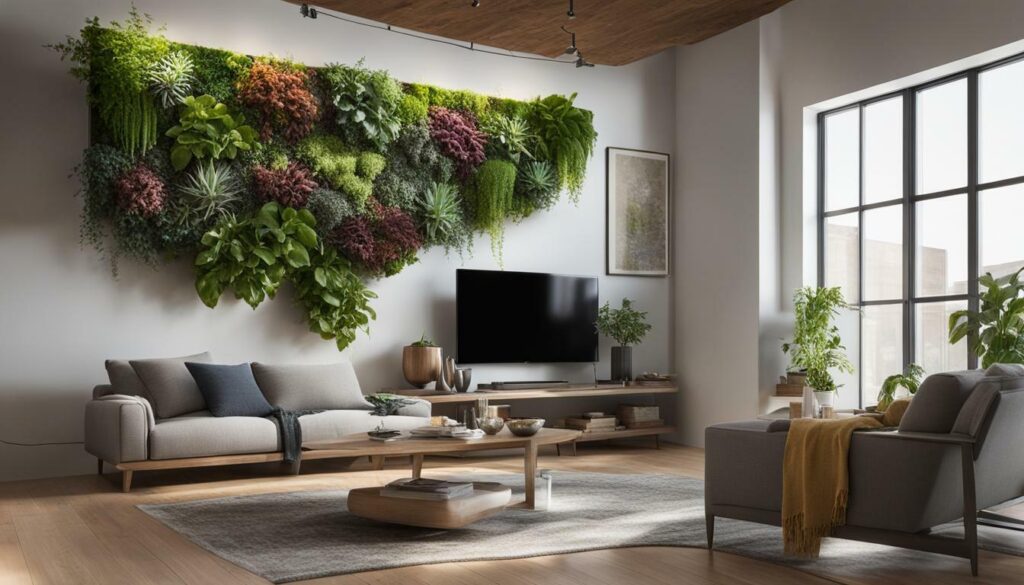
With The Wall Farm Indoor Vertical Garden, you can create a lush and vibrant indoor garden that will enhance the beauty of your space. Its innovative design and features make it easy to maintain and grow a wide variety of plants. Whether you’re a seasoned gardener or just starting out, The Wall Farm is the perfect solution for transforming your space into a green oasis.
DIY Vertical Garden Ideas for Small Spaces
If you’re short on space but still want to enjoy the benefits of a vertical garden, there are several DIY ideas that can help you create a beautiful indoor garden.
1. Vertical Pallet Planter:
One of the easiest and most cost-effective ways to create a vertical garden is by repurposing a wooden pallet. Simply attach planters or pots to the pallet and hang it on a wall. This allows you to create a stunning vertical garden without taking up precious floor space.
2. Dresser Planter:
If you have an old dresser lying around, don’t throw it away! Transform it into a unique vertical garden by planting ferns and succulents in the drawers and on top of the dresser. This not only adds greenery to your space but also adds a touch of charm to your decor.
3. Indoor Ladder Planter:
An old ladder can be repurposed into a functional and stylish vertical garden. Add wooden planks or shelves to the ladder’s steps and use them as individual planters. Make sure to group plants with similar light requirements to ensure their growth.
4. DIY Pot Hanger:
Create a unique display for your favorite houseplants by making a DIY pot hanger. Use scrap wood, rope, and basic woodworking tools to create a hanging system for your pots. This not only adds a touch of creativity to your space but also makes watering your plants a breeze.
| Idea | Materials | Space Required | Maintenance |
|---|---|---|---|
| Vertical Pallet Planter | Wooden pallet, planters/pots | Minimal floor space | Low maintenance |
| Dresser Planter | Old dresser, ferns and succulents | Minimal floor space | Low maintenance |
| Indoor Ladder Planter | Old ladder, wooden planks, plants | Vertical space | Medium maintenance |
| DIY Pot Hanger | Scrap wood, rope, pots | Vertical space | Medium maintenance |
These DIY vertical garden ideas allow you to add a touch of greenery to your home, even in the smallest of spaces. Whether you repurpose old furniture or create your own hanging systems, there are plenty of options to suit your style and needs. Get creative and start building your own vertical garden today!
“Gardening is the art that uses flowers and plants as paint, and the soil and sky as canvas.” – Elizabeth Murray
Benefits of Biophilic Design and Living Walls
Biophilic design, which incorporates plants and nature into indoor spaces, offers numerous benefits including stress reduction, improved air quality, and increased productivity. By bringing elements of the natural world indoors, biophilic design creates a more harmonious and calming environment.
One of the main advantages of biophilic design is its ability to reduce stress levels. Research has shown that exposure to nature and natural elements has a positive impact on our mental well-being, helping to lower stress and anxiety. Incorporating plants and greenery into indoor spaces can create a sense of tranquility and promote relaxation.
Another benefit of biophilic design is improved air quality. Plants naturally purify the air by absorbing carbon dioxide and releasing oxygen. They can also filter out toxins and pollutants, creating a healthier indoor environment. The presence of plants can reduce the symptoms of allergies and respiratory conditions, allowing individuals to breathe easier.
Furthermore, biophilic design has been found to enhance productivity and focus. Studies have shown that exposure to nature can improve cognitive function and boost creativity. Having plants in the workspace or living area can increase concentration levels and contribute to a more positive and productive mindset.
Living Walls: A Biophilic Design Element
One popular element of biophilic design is the living wall, also known as a green wall. Living walls are self-supporting gardens that can be attached to the interior or exterior of a building. These vertical gardens not only add beauty to a space but also provide numerous benefits.
Living walls have been shown to improve air quality, reduce noise levels, and regulate temperature and humidity. They create a sense of tranquility and connection to nature, even in urban environments. Additionally, living walls can help to reduce energy consumption by providing insulation and shading.
Creating a living wall can be a DIY project or installed by professionals. It involves selecting suitable plants for vertical growth, installing a support structure, and ensuring proper irrigation and maintenance. There are various types of living walls, including modular systems, freestanding structures, and hydroponic setups.
Case Study: The Benefits of Living Walls in the Workplace
In a study conducted by the University of Exeter, researchers found that employees in offices with greenery, including living walls, reported higher levels of well-being and productivity. The presence of plants in the workspace was associated with improved air quality, reduced stress levels, and increased job satisfaction.
The study also found that employees who were exposed to nature indoors were more likely to engage in physical activity, such as taking walks during breaks. The combination of biophilic design and access to green spaces within the office environment contributed to a healthier and more active workforce.
Overall, the incorporation of biophilic design and living walls in indoor spaces has a positive impact on human well-being. By bringing nature indoors, we can create a more harmonious and nurturing environment that promotes health, productivity, and a sense of connection to the natural world.
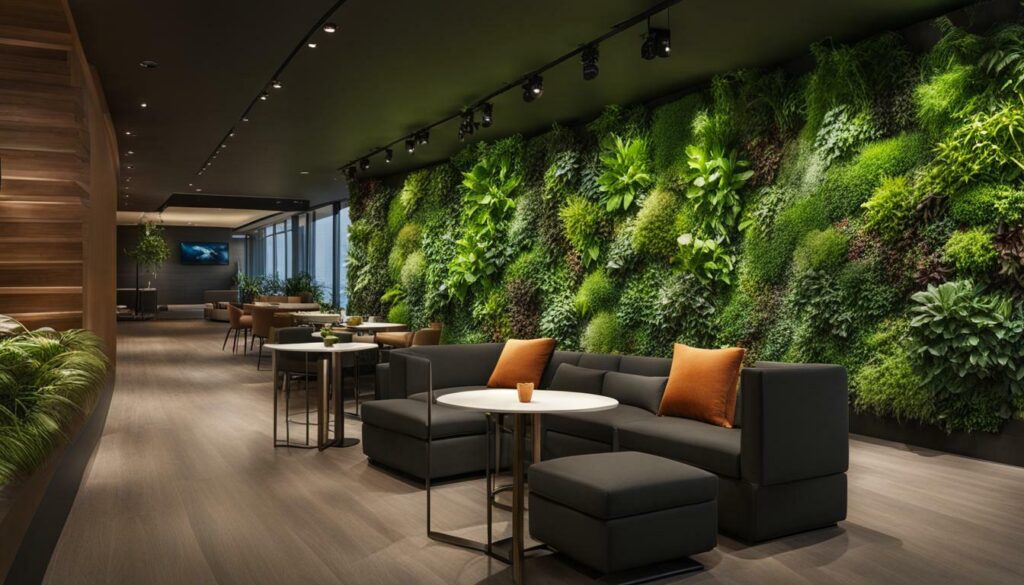
| Type of Living Wall | Benefits |
|---|---|
| Modular Systems | Easy installation and maintenance |
| Freestanding Structures | Can be moved and reconfigured |
| Hydroponic Setups | Water-efficient and low-maintenance |
Tips for Designing Your Own Vertical Garden
Designing your own vertical garden requires careful consideration of lighting and temperature conditions, as well as choosing the right plants for your space. Here are some helpful tips to get you started:
- Assess your space: Before you begin designing your vertical garden, take a look at your space and determine how much sunlight it receives and what the temperature is like. This will help you choose the right plants that will thrive in your specific environment.
- Choose the right plants: Select plants that are suitable for vertical gardening and can handle the conditions of your space. Consider plants that have shallow root systems, such as herbs, leafy greens, and succulents. These plants are well-suited for vertical gardens and can thrive in a smaller amount of soil.
- Plan your layout: Decide how you want to arrange your plants in your vertical garden. Consider factors such as plant size, color, and growth habits. You can create a visually appealing design by mixing different plant varieties and arranging them in a way that creates a pleasing pattern or composition.
- Provide proper support: Make sure your vertical garden has a sturdy support structure that can hold the weight of the plants and soil. This can be a wall-mounted system, a freestanding frame, or even a hanging design. Ensure that the structure is secure and can withstand the weight and movement of the plants.
By following these tips, you can design and create your own vertical garden that will transform your space and bring nature indoors.
Example of a Vertical Garden Layout:
Here is an example of a simple vertical garden layout:
| Plant | Light Requirements | Watering Needs | Growth Habit |
|---|---|---|---|
| Herbs (Basil, Thyme, Rosemary) | Full sun | Regular watering | Upright |
| Succulents (Aloe Vera, Echeveria) | Bright indirect light | Infrequent watering | Low-growing, rosette-shaped |
| Leafy Greens (Lettuce, Spinach) | Partial shade | Regular watering | Leafy, compact |
This layout incorporates different types of plants with varying light and water requirements. By arranging them in a vertical garden, you can optimize space and create a visually appealing display.
“A well-designed vertical garden can not only add beauty to your space but also provide fresh herbs and vegetables for cooking.”
What Are the Benefits of an Indoor Vertical Wall Garden and How Does It Differ from Traditional Gardens?
The indoor vertical garden system revolutionize the way we think about gardening. With this innovative approach, you can enjoy the benefits of gardening without taking up a lot of space. Traditional gardens require a lot of outdoor space and maintenance, while the vertical wall garden is perfect for smaller indoor spaces and requires less maintenance.
Conclusion
Vertical wall gardens offer a unique and innovative way to bring nature indoors, transforming your space into a thriving, green oasis. Whether you have limited space, want to improve air quality, or simply want to add a touch of greenery to your home or office, a vertical garden is the perfect solution.
One of the key benefits of vertical gardening is its ability to maximize space. By utilizing the vertical plane, you can grow a variety of plants, from herbs and vegetables to flowers and succulents, without taking up valuable floor space. This is especially beneficial for those living in small apartments or urban environments where space is limited.
Vertical gardens are also easy to set up and maintain. Many systems come with automatic watering features, eliminating the need for constant watering and making them ideal for busy individuals. Additionally, vertical gardens can improve air quality by filtering toxins and releasing oxygen, creating a healthier and more enjoyable living environment.
When choosing a vertical gardening system, it’s important to consider factors such as the type of system, measurements, growing capacities, watering options, and warranty. Systems like Lettuce Grow and The Wall Farm Indoor Vertical Garden offer advanced hydroponic and LED lighting technology, making them efficient and effective choices for indoor gardening.
If you prefer a more DIY approach, there are plenty of creative ideas to choose from, such as using a vertical pallet planter or repurposing an old dresser. These DIY options allow you to customize your vertical garden to suit your style and space requirements.
Overall, indoor vertical gardening not only allows you to enjoy the benefits of fresh, homegrown produce but also adds a touch of nature and beauty to your surroundings. With a wide range of systems and design options available, there’s a vertical garden solution for every space and gardening preference. So, why wait? Start transforming your space with a vertical wall garden today and reap the rewards of a greener, more vibrant indoor environment.
FAQQ: What are the benefits of vertical gardening? A: Vertical gardening allows you to maximize space and make use of small areas. It is easy to set up and maintain, improves air quality, and is eco-friendly.Q: What is a vertical garden? A: A vertical garden is a garden that is planted in vertically stacked layers or in a hanging structure. It is a great way to grow herbs, vegetables, and flowers in small spaces.Q: How do I choose the right vertical garden system? A: When choosing a vertical garden system, consider factors such as the amount of space you have, how many plants you want to grow, and your budget.Q: What is a hydroponic vertical garden system? A: A hydroponic vertical garden system is a system that uses water and nutrient solutions to grow plants without soil. It is a highly efficient and low-maintenance method of gardening.Q: What is Lettuce Grow? A: Lettuce Grow is an all-in-one hydroponic system that allows you to grow your own food easily and conveniently. It uses organic seeds, LED grow lights, and a water distribution system for optimal plant growth.Q: What is The Wall Farm Indoor Vertical Garden? A: The Wall Farm Indoor Vertical Garden is an innovative vertical gardening system with three shelves and 51 growing cavities. It is perfect for both beginners and experienced gardeners.Q: What are some DIY vertical garden ideas for small spaces? A: Some DIY vertical garden ideas for small spaces include using pallets, dressers, ladders, shoe organizers, and mason jars to create unique and space-saving gardens.Q: What are the benefits of biophilic design and living walls? A: Biophilic design, which incorporates plants and nature into interior spaces, has been shown to reduce stress, improve air quality, and enhance focus and productivity.Q: What are some tips for designing your own vertical garden? A: When designing your own vertical garden, consider the light and temperature conditions of the space, choose plants that will thrive in those conditions, and select a vertical garden system that suits your needs and preferences.Q: How can I transform my space with a vertical wall garden? A: By adding a vertical wall garden, you can bring nature into your space, improve air quality, and create a beautiful and relaxing environment.Q: What is the conclusion of the article? A: Vertical gardening is a practical and efficient way to grow plants indoors. With the right system and design, you can transform your space and enjoy the benefits of homegrown produce and a greener living environment.
